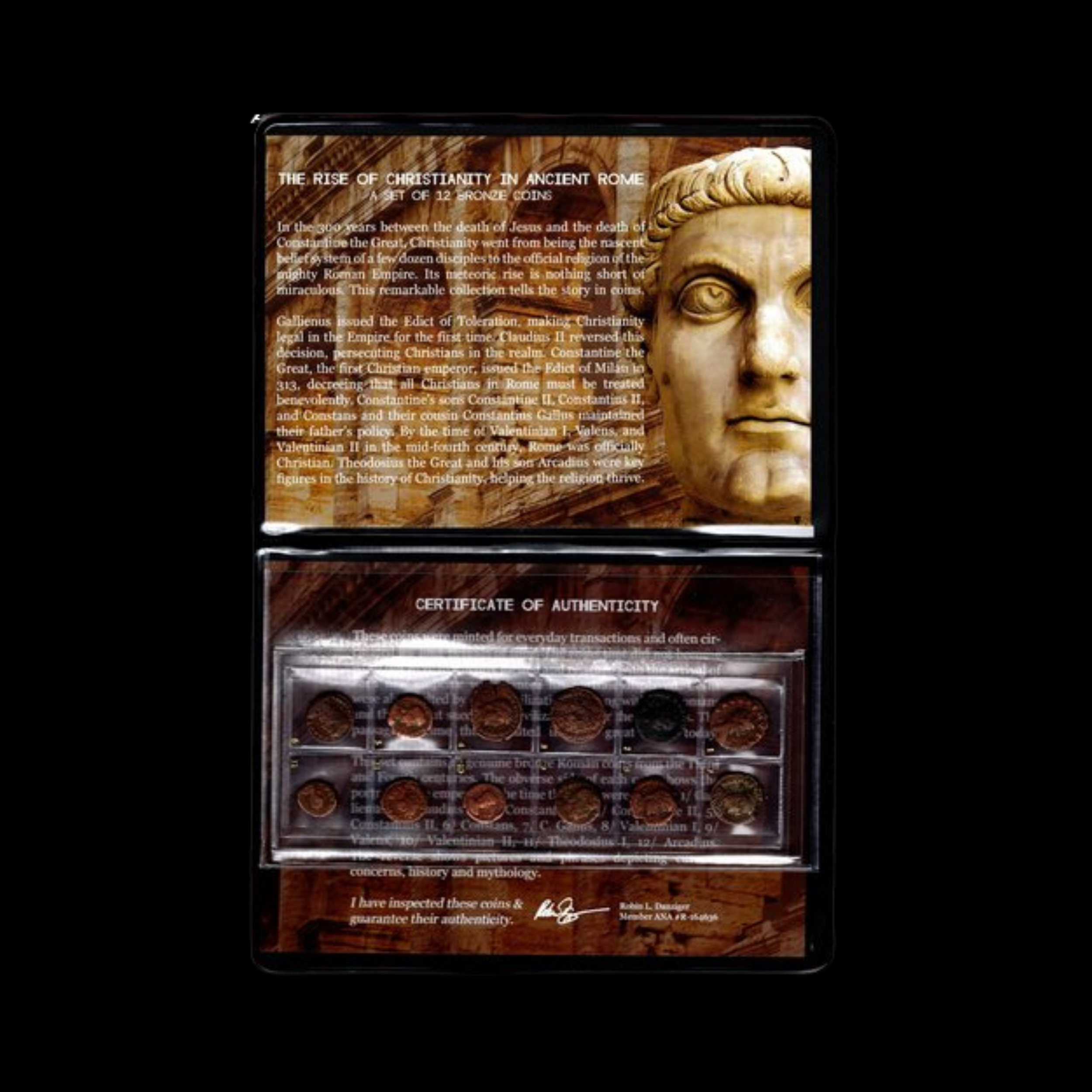 Image 1 of 8
Image 1 of 8

 Image 2 of 8
Image 2 of 8

 Image 3 of 8
Image 3 of 8

 Image 4 of 8
Image 4 of 8

 Image 5 of 8
Image 5 of 8

 Image 6 of 8
Image 6 of 8

 Image 7 of 8
Image 7 of 8

 Image 8 of 8
Image 8 of 8









Constantine I, The Great (Sol Invictus) Roman Bronze Coin (about 1,700-1,750 years ago)
This is a bronze coin featuring Constantine the Great, the Roman emperor who transformed the empire by officially embracing Christianity and establishing it as the dominant religion of the Western world.
Coin Description:
Front side: Portrait of Emperor Constantine I
Back side: Depicts "Sol Invictus" (Unconquered Sun), considered by some to be the first numismatic representation of Jesus Christ
Technical Details:
Bronze composition
Certified by NGC
Minted during Constantine's reign (272-337 CE)
Historical Significance: Constantine the Great was the first Christian Emperor of Rome. His conversion and subsequent policies fundamentally changed the course of Western history by making Christianity the official state religion of the Roman Empire. This elevated what had been a persecuted religious minority into a position of prominence it would enjoy for 20 centuries and counting. This particular coin is especially significant as it features both Constantine's likeness and a depiction of Sol Invictus (the "Unconquered Sun"), which some scholars interpret as the first known numismatic representation of Jesus Christ. This imagery reflects the transitional period when Roman religious symbolism was beginning to incorporate Christian elements.
This is a bronze coin featuring Constantine the Great, the Roman emperor who transformed the empire by officially embracing Christianity and establishing it as the dominant religion of the Western world.
Coin Description:
Front side: Portrait of Emperor Constantine I
Back side: Depicts "Sol Invictus" (Unconquered Sun), considered by some to be the first numismatic representation of Jesus Christ
Technical Details:
Bronze composition
Certified by NGC
Minted during Constantine's reign (272-337 CE)
Historical Significance: Constantine the Great was the first Christian Emperor of Rome. His conversion and subsequent policies fundamentally changed the course of Western history by making Christianity the official state religion of the Roman Empire. This elevated what had been a persecuted religious minority into a position of prominence it would enjoy for 20 centuries and counting. This particular coin is especially significant as it features both Constantine's likeness and a depiction of Sol Invictus (the "Unconquered Sun"), which some scholars interpret as the first known numismatic representation of Jesus Christ. This imagery reflects the transitional period when Roman religious symbolism was beginning to incorporate Christian elements.
This is a bronze coin featuring Constantine the Great, the Roman emperor who transformed the empire by officially embracing Christianity and establishing it as the dominant religion of the Western world.
Coin Description:
Front side: Portrait of Emperor Constantine I
Back side: Depicts "Sol Invictus" (Unconquered Sun), considered by some to be the first numismatic representation of Jesus Christ
Technical Details:
Bronze composition
Certified by NGC
Minted during Constantine's reign (272-337 CE)
Historical Significance: Constantine the Great was the first Christian Emperor of Rome. His conversion and subsequent policies fundamentally changed the course of Western history by making Christianity the official state religion of the Roman Empire. This elevated what had been a persecuted religious minority into a position of prominence it would enjoy for 20 centuries and counting. This particular coin is especially significant as it features both Constantine's likeness and a depiction of Sol Invictus (the "Unconquered Sun"), which some scholars interpret as the first known numismatic representation of Jesus Christ. This imagery reflects the transitional period when Roman religious symbolism was beginning to incorporate Christian elements.
Constantine I[g] (Latin: Flavius Valerius Constantinus; 27 February c. 272 – 22 May 337), also known as Constantine the Great, was a Roman emperor from AD 306 to 337 and the first Roman emperor to convert to Christianity.[h] He played a pivotal role in elevating the status of Christianity in Rome, decriminalizing Christian practice and ceasing Christian persecution. This was a turning point in the Christianization of the Roman Empire. He founded the city of Constantinople and made it the capital of the Empire, which it remained for over a millennium.
Born in Naissus, in Dardania within Moesia Superior (now Niš, Serbia), Constantine was the son of Flavius Constantius, a Roman army officer of Illyrian origin who would become one of the four emperors of the Tetrarchy. His mother, Helena, was a woman of low birth, probably from Asia Minor in modern Turkey. Later canonised as a saint, she is credited for the conversion of her son in some traditions, though others believe that Constantine converted her. Constantine served with distinction under the Roman emperors Diocletian and Galerius. He began his career by campaigning in the eastern provinces (against the Persians) before being recalled in the west (in AD 305) to fight alongside his father in the province of Britannia. After his father's death in 306, Constantine was proclaimed as augustus (emperor) by his army at Eboracum (York, England). He eventually emerged victorious in the civil wars against emperors Maxentius and Licinius to become the sole ruler of the Roman Empire by 324.
You Might Also Like



























